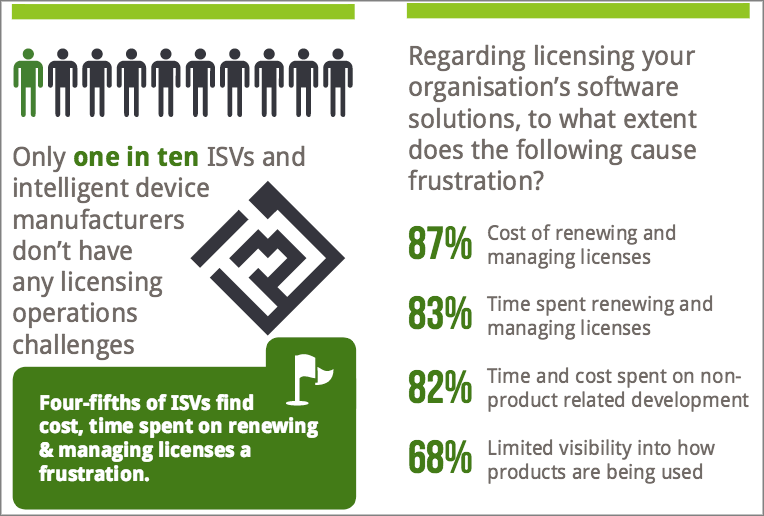Matching Software Licensing To The Needs Of The End User
Software licensing components are either home-grown or available as purchasable software components. Common services that end user licensing needs to manage software apps include:
- Requesting personalization (example: user name/password or machine ID).
- Verifying that the installation is authorized (and if not, refusing to run the app) for use, update, and support.
- Allows full use, a temporary trial, or specific features to be enabled.
- Optionally, provide an interface for audit of app usage, statistics, and other interesting patterns identified by the end user (or device).
There are many software tool providers who provide license management components in the forms of software development toolkits. SoftwareKey System is one vendor that provides this capability on a variety of platforms including desktop operating systems and even Linux running many of today’s embedded devices.
How Innovative Companies Define End User Licensing
It is easy to superficially explain the reasons for end user license management. Most anyone in a software development organization can explain what they do for end user license management. How software license is also straightforward. Understanding why is far more important. Simon Sinek’s explains the importance of defining a product, service, or (in our case) software licensing as the why before the what and the how. [1]

Figure 1: Innovative companies start with the why and then define the how and then the what (not the other way around)
It is summarized in something called an end user license agreement (EULA, for short) that supposedly binds you to specific rules you must agree to before using the software. Oftentimes, EULAs tend to be so wordy and confusing that most people don’t even bother digesting the pages of “thou shalt not” legalese. The EULA is the what.
Fewer people in a software development organization can explain the how end user license protection works, but you as the end user will quickly find out when you are locked out from using it! The software algorithms used to enforce the license is the how.
Inspired and innovative companies focus their energies on the why. For end user license technology, they why is definitely not simply a unique selling proposition or corporate double-speak like “to save us from being ripped off from bad users” or “ensures that we receive our justified revenue”. That is more of a result. Instead, I propose that the why is a reasoning that results in a win-win between the end user and the software app provider. Here’s an example of a well-articulated why: “We trust our customer and in order to keep their software updated and to provide the best technical support possible, we end users need to be authenticated.”
Some Statistics You Might Find Interesting
It seems to me that software vendors are failing their customers when it comes to providing reasonable software licensing methodology while not frustrating the end user (the customer). Apparently I’m not alone in this view. Figure 2 highlights recent statistics from a recent technical community survey hosted by the Gemalto Group. [2]

Figure 2: Software licensing frustration abounds both with the software vendor and the customer.
According to their November 2015 study, Gemalto found that only one in ten independent software vendors (ISVs) didn’t have tough software licensing logistics to deal with. And for customers who were involved with software licensing, at least 80 percent of them struggled with the cost and time spent managing software licensing.
Analyst firm Gartner estimates that more than $400bn was spent on software licensing worldwide last year, with between five to six percent of the total generated by audits.
I can testify to the same frustration.
Recently, I’ve had the “pleasure” of dealing with software licensing issues for my organization where the complexities of dealing with so-called online licensing eventually needed intervention with several vendor support specialists. The problem was never really resolved and I ended up switching software vendors as a result.
8 Rules Of The Road
Like so many technology providers claiming that “the customer is #1”, in practice, nothing could be farther from the truth. There are common-sense approaches that we, as software developers, can put into place to make software licensing effortless to deploy and easy to use. This is my top 8 pet peeves:
- Assume the customer is a bona fide user.
In other words, trust the customer. If they are having a hard day and they enter in the password incorrectly more than three times, don’t lock them out. - Simplify the EULA.
You shouldn’t need a lawyer to understand your rights to use the software. If you don’t know how to simplify your EULA, use the Hemingway app to help simplify your sentences. Best of all, their online version is currently free to use. - Trial periods are for losers.
The software industry is littered with customers that have dropped a software vendor because they ran out of time to try it. What’s worse is if you lose the ability to access data after an expired trial period. Many vendors make it impossible for a well-intentioned customer to try the software out – shoot, we all get busy. Are you trying to earn the right to add a new customer or put time pressure on them? - Exceeding maximum installations.
This is a big one! Software developers are getting smart with development of apps that can be installed on more than one computing device with a single user ID (usually an email address). The modern computer user has a couple of desktop computers, a laptop, and a smart phone. As long as the end user isn’t using more than one device at a time, why do you care? Let them install the software on as many devices as they own. - Abrupt termination of license.
I’ve personally experienced an unexpected licensing problem with a major software vendor. Out of the blue, a valid licensed product’s serial number became illegal. Even though I owned a legitimate copy of the software, I was challenged by a support specialist insinuating that I had made a legitimate purchase. I had valid license proof, but I felt on the defensive. They lost a customer for good. - Oh no, there’s no internet connection.
Some corporations don’t allow systems behind a firewall to have wide-open internet access. This is even true with industrial embedded devices in a factory where wireless access is spotty at best or with mobile devices where the device loses wireless coverage. The software license management code that periodically does a background check for a valid license over the internet will fail and, in some cases, the app stops working. Bad, bad, bad. - User identification.
Make it possible for the user to identify some unique identifier that can be used for support with the vendor in case of trouble. How often have you clicked on your Windows About box and read what you think is a valid serial number to a support technician only to be told that is non-existent, obfuscated serial number. - Make it possible to transfer licenses.
Let’s face it. As workers leave and join companies, tying a software license specifically to one person is asking for trouble. Being able to transfer a license to another name is an absolute necessity. We’ve all found creative ways to get around it by either creating a bogus email address or use a generic one, like [email protected]. That is just asking for confusion down the road.
Should History Repeat Itself?
Yet another organization, Campaign for Clear Licensing, has been created to solve this problem. Mark Flynn, their CEO, says it best. “We believe end user organizations need effective representation because everybody wants to be legal, everybody wants to invest in software. But often licensing agreements are incredibly complicated. You often need a law degree as an IT person or a buyer really to understand them.” [3]
Some of you may not remember this, but in the 1980s commercial desktop software provided all sorts of end user safety checks that were close to vengeful. I remember one app that if it couldn’t authenticate you, a ten second countdown timer would end by automatically reformatting your hard drive. To add insult to injury, as the software was counting down it displayed a bomb dropping on the video monitor.
Already mentioned in this article, EULAs have become too complex for the average user to comprehend. Years back, Borland International came out with a one-page No-Nonsense EULA that was a work of art. It was simple, written in a way that was easy to understand, and actually gave the reasons why a license was needed in the first place. [4]
Why haven’t more of the software development community learned from Borland?
I’m calling on all software developers servicing the embedded world to trust the customer and employ license policies that benefit everyone.
References:
- Sinek, Simon. “How Great Leaders Inspire Action.” TED. September 2009.
- Gemalto NV. “Software licensing: expectations, challenges, and the future.” The State of Software Monetization. November 2015.
- Wolpe, Toby. “Software licensing: This man thinks it's time someone stood up for the end user.” ZDNet. July 28, 2014.
- Zeldes, Nathan. “Don’t you miss Borland’s no-nonsense EULA?” Commonsense Design. May 30, 2008.



